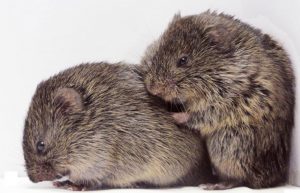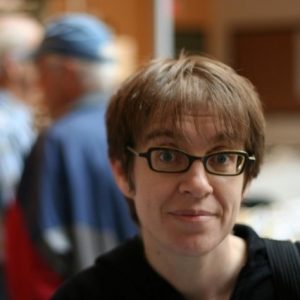
Angela Willey’s talk attracted a Dionysian throng of inverts to the Science Studies seminar room — about thirty queers of color, transmen, dykes, and fellow travelers packed into the space at noon on Monday to hear Professor Willey’s critique of the ways in which monogamous pair bonding is written into sex science as a naturalized moral order. She gave us an overview of her recent book Undoing Monogamy, including a tantalizing taste of her chapter about a lab studying the mating behaviors of two sub-species of vole, one monogamous and the other promiscuous.
Famously, it seems to be possible to turn a monogamous vole into a promiscuous one and vice versa by manipulating the genes that encode for hormone receptors. Knock out a prairie vole’s oxytocin receptors and it develops a wandering eye. Insert the same genes into a meadow vole and it starts to exhibit ‘pair-bonding’ behavior. This discovery has generated a lot of scientific excitement, some silly books about how to ‘Make Love Like a Prairie Vole,’ and an oxytocin spray, as well as some speculative leads into the genetic basis of autism, of which more below.
In her riveting chapter on the prairie vole research in Undoing Monogamy Willey unpacks the ways that this work naturalizes the moral order of heterosexual coupling. First, the ‘monogamous’ vole is no such thing. While pairs of prairie voles do cohabit and co-parent, DNA testing recently established that the offspring of a couple were often not related to the male, indicating that plenty of ‘extra-pair copulation’ was in fact going on. The scientists use ‘monogamous,’ ‘socially monogamous’ and ‘pair-bonded’ interchangeably, by which terms they seem to mean a sort of rodent open relationship, along the lines of ‘we live together, but we can fool around outside the home.’ By using these terms interchangeably, however, they give the impression that sexual exclusivity is really what is at stake. Willey then analyzes the circular logic by which the ‘pair-bonded’ voles have become proxies for normally socially attuned humans, while the ‘promiscuity’ of the other sub-species stands in for social pathology. The genes that encode for oxytocin receptors are now counted as plausible candidates for the biological basis of autism.
Of course, all of this sexy stuff is catnip for pop science writers. The readers of science journalism can now be led to believe 1. that a prairie vole practices sexual exclusivity and that this is a marker of the ability to bond with others 2. that this bonding behavior is a clue as to the genetic basis of normal sociality in humans, and 3. that the ‘promiscuity’ of a meadow vole gives us a valid lead into the genetics of human autism. By virtue of these slippages, translations, and circularities, we arrive at the full valorization of what Willey hilariously characterized in her talk as “the search for someone to file taxes with.”
By coincidence, the colloquium talk in the evening also described an ethnography of a hormone receptor lab. This presentation was by Joyce Havstad, who got her PhD here at UCSD in Philosophy and Science Studies in 2014. She outlined her observation of a lab at the Salk Institute. The lab in question is dedicated to elucidating the action of a “super-family of nuclear hormone receptors.” The purpose of Joyce’s study was to test the conclusions of Latour and Woolgar’s book Laboratory Life, a provocative anthropological observation of the goings-on in a different lab at the Salk from 1979.
Joyce-as-ethnographer was the consummate insider. She had worked at the lab in question for seven years as a technician. For her, in contrast to Latour and Woolgar, the practitioners in the lab are discovering truths about the structure of their objects. As she interacted with the scientists, some of them her erstwhile colleagues, her aim became to generate a description of scientific practice that captured – better than Laboratory Life’s deliberately estranged and cynical outsider view – how scientists themselves understand the nature and purpose of their activities.
in some ways, Willey and Havstad encompass the range of approaches in Science Studies at UCSD. The realist philosopher of science on the one hand, the queer feminist critic of science on the other, both studying aspects of hormone receptor science. Even with the best will in the world, it can be hard to get these two sides onto common ground. Listening to these two presentations back-to-back, however, offered some commensurable terrain between the two approaches.
First and perhaps most importantly, both talks occupied what might be called a hyper-realist framework, taking seriously the molecules as well as all the other entities, including practices, equipment, discourses, performances, social institutions, reward structures, and historical contexts (Hannah Landecker’s presentation was also exemplary in this regard). Both talks engaged a self-reflexive mode, making more explicit the personal investments and ethical commitments behind the projects. The speakers are both feminists. Self-reflexive, ethically-committed feminist science studies – from Evelyn Fox Keller to Donna Haraway to Angela Willey, Banu Subramaniam, and Kalindi Vora – has always held fast to the possibility that both science and society might be served by a realist analysis of the ways in which they mutually constitute one another. Can we build on this legacy at UCSD to map the grounds for productive interdisciplinary communication?
